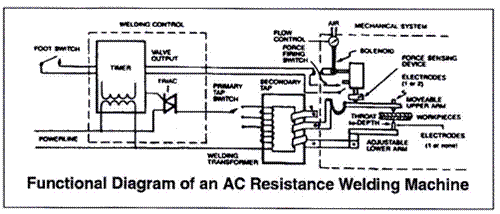- The AC welder derives its name from the fact that is output is generally a sine wave of the frequency as the power line. It extracts energy from the power line as the weld is being make. For this reason, the power line as the weld is being made. For this reason, the power line must be well regulated and capable of providing the necessary energy. Gome AC welders (including all Unitek Equipment AC welders) include a line voltage compensation feature to automatically adjust for power line fluctuations. In its simplest form, the AC welder consists of a welding transformer that steps down the line voltage (normally between 480 to 100 volts) to the welding voltage (typically 2 to 20 volts). The welding current that flows through the secondary of the transformer, and its connected load, is very high, ranging from 10 to more than 100,000 ams. The welding current is allowed to flow for very short periods of time, typically .001 to 2 seconds. AC welders can operate at rates up to 5-6 welds per second.
AC Welding Systems are generally composed of the three elements. The Welding Transformer, the Welding Control, and the Mechanical System.
- Welding Transformers - are used in AC machines to change alternating current from the power line into a low-voltage, high amperage current in the secondary winding. A combination of primay and /or secondary taps on the welding transformer are commonly used to provide a macro adjustment of the welding current, as well as adjustment of secondary voltage. Transformer ratings for AC machines are expressed in KVA (kilovolt-amperes) for a specified duty cycle. This duty cycle rating is a thermal rating and indicates the amount of energy that the transformer can deliver for a stated percentage of a specific time period, usually one minute, without exceeding its temperature rating. The RMS Short Circuit Secondary Current specification indicates the maximum current that can be obtained from the transformer. Since heating is a function of the welding current, this parameter gives an indication of the thickness of the materials that can be welded.
Recent advances in AC welding technology have adapted constant current feedback control at the line frequency (50 or 60 Hz) which can be useful for welds longer than 5 cycls (82-100 milliseconds) by automatically adjusting the power supply parameters.

